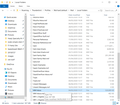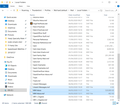
New TB Version Disallowing New Account For Existing Message Folder ?
I saw that my saved email passwords had Site descriptors that mentioned my old mail hosting company. For example, one saved password would have a Site field entry like
mailbox://mail.oldhost.com (mailbox://mail.oldhost.com)
whereas another would have its Site entry like:
mailbox://cpanelxx.newsecurehost.com (mailbox://cpanelxx.newsecurehost.com)
I tried to solve this by deleting the mail account (but not the associated mail folder) then recreating an email account with the same address. I got the new email account but nowhere in the set-up process was I allowed to reconnect the mail for the new account to its old folder. Instead a new folder named with the address was created which had its own Inbox sub-folder. Unlike old versions of TB, I could not destroy the new Inbox sub-folder, nor move the new folder within my Local Folders nor rename it. So now I have 2 folders for mail coming to that one address. On testing (despite a filter explicitly directing it to its old folder) the mail for the recreated address is automatically put into the new folder's Inbox.
Is there anyway to do things the old way ?
所有回复 (5)
I'm going to assume this is a POP account. Go to Tools > Account Settings > Server Settings for the affected account. Under the Message Storage section there is a field for the Local directory used by this account. Browse and set this path to that of the old folder. Exit and restart thunderbird.
I was trying that but it won't allow me to select the existing folder for that email address. I can use the file explorer to locate the old message folder. But it won't allow that one to be selected. See error message screenshot.
You're getting things mixed up. That WM Inbox that you've selected is NOT a folder. As you can see, it is a FILE as indicated in the type column of the File Explorer window. It is a file without an extension. Also, you're looking at the local directory for the Local Folders account. Did you deliberately configure the deleted account to originally use the Mail\Local Folders directory which is also used by the Local Folders account?
Did you deliberately configure the deleted account to originally use the Mail\Local Folders directory which is also used by the Local Folders account? I configured the deleted email account to store messages in Local Folders\WM Inbox. WM Inbox was a folder I had created beforehand on the TB GUI by right-clicking on the Local Folders icon and selecting New Folder. TB then (I assume) created the WM Inbox file within Local Folders. At any rate there are other files in the Local Folders with the same names as the receiving inboxes that I created for them.
由tamjk于
Local Folders contents attached




